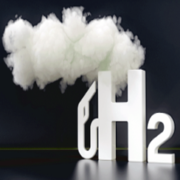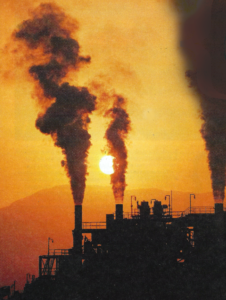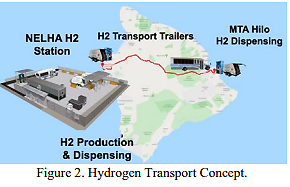Energy; the Big Picture
Globally, oil, gas and coal benefited from $7tn in taxpayer subsidies and support in 2022 despite being the primary cause of today’s climate crisis
- Fossil fuels received benefited record global subsidies to the tune of $13,000,000 a minute in 2022, according to the International Monetary Fund.
The explicit gas and oil subsidies cut the price of unsustainable fossil fuels for consumers more than doubled in 2022, as countries responded to higher energy prices resulting from Russia’s war in Ukraine. These implicit energy subsidies represent “enormous” costs to society and the environment by advancing global heating emissions. Upwards to 80% of the total climate impacts and their mitigation costs are shared by the world’s population, regardless of their location as the recent Maui fire tragedy demonstrated.
Extreme weather, fueled by dirty energy, added costs for U.S. taxpayers to the tune of $165 billion in 2022. There were 18 separate multi billion-dollar climate disasters which highlighted the growing cost of climate change on the Federal budget and those citizens and businesses otherwise directly affected.
Beyond the added cost-to-taxpayers, global heating impacts has translated into a growing economic impact on the P&C insurance sector, and by extension, the broader economy. Homeowners, rental housing, and commercial building sectors are all experiencing an unprecedented rise in property claims and insurance costs. Whether you own or rent, insurance rates are going up and in some cases way up raising the cost of living for all affected.
In some markets such as California, major insurance providers have stopped issuing P&C insurance policies to new customers or pulled out entirely in states with rising climate-related risks and claim costs. The impact of the Maui fire this year, beyond the social and economic losses, was a wake up call to local insurers. Forthcoming P&C insurance rates on the rise, with both economic and social consequences on insured properties – impacts not yet been fully realized by the residents and businesses of Hawaii.

Hawaii’s Energy Outlook
Energy-driven climate costs in Hawaii are measured less in terms of their economic, social and environmental impacts, and more in terms of energy substitution costs.
State energy priorities are generally determined by a group of select stakeholder interests, beginning with Hawaiian Electric (HE) and its direct and indirect investments in old line combustion power plants throughout the state. Most recently, the utility’s 2023 purchase of Kauai’s only biomass burn plant. So far, these investments have guided the utility’s decisions towards fulfilling its so-called renewable energy obligations which guide utility energy choices designed to meet statewide regulatory obligations outlined within Hawaii’s Renewable Portfolio Standard (RPS).
The deadline for the fulfillment of the utility’s 100% renewable energy RPS energy transition is 2045. A lot remains to be done within the time remaining and so far HE is off to a slow start. Beyond addressing recent liability lawsuits associated with the Maui fire, Hawaiian Electric has been increasingly saddled with multiple transition challenges, most of which are the result of the utility’s own management decisions, and not opportunities for transformational change and operating improvements.
In response to the state’s renewable energy policy (RPS), Hawaiian Electric’s transition has been driven not by regulatory necessity, but shareholder profits. These same shareholder priorities have somehow not paralyzed mainland utilities towards advancing their grid investments or meeting state-mandated clean energy alternatives and substitutions defined by similar RPS mandates and deadlines. Yet, HE’s Hawaii Island operating unit, HELCO, has historically spent its time and ratepayers money slow walking its pursuit of fossil fuel substitutes.
The utility’s alternative energy replacements do not face significant technology challenges, rather they offer operating efficiencies, but face a wall of resistance created the utility’s own historic investments in an over-weighted energy dependency on imported diesel and oil and combustion power plants to burn fossil fuels.
Taking advantage of loopholes in the state’s RPS rules the utility help design during its legislative creation process, the utility has, and continues to vigorously pursued unsustainable biomass power plants to argument their fossil fuel investments as a means of regulatory compliance, and mostly exemplified by poor energy substitution choices. These utility actions come at time as a 21st century world is fighting a human-made, and runaway, climate experiment fueled by burning fossil fuels and biomass (from trees-to-trash) just to generate electricity.
HE’s utility energy choices matter. These same energy choices emit GHG emissions and contribute to accelerating global heating (locally and globally). If that were not enough, the utility’s combustion power bias adds to the state’s costly air and water pollution impacts on our local communities and environment. But the real salt-in-the-wound impact is immediately felt by ratepayers from these expensive energy choices, infamously continuing to make Hawaii the most expensive energy market in the United States.
Hawaiian Electric’s big island power profile is far from unique for an electric utility still operating in the 20th century, and one heavily invested in old line combustion power plants with an energy bias firmly rooted in obsolete profit models.
Today’s big island electric utility profile strongly supports this conclusion:
HELCO-owned Oil-fired Combustion Power Plants (Oil)
Keahole: 77.6 MW (Combustion)
Puna: 36.7 MW (Combustion)
Kanoelehua: 21 MW (Combustion)
Waimea: 7.5 MW (Combustion)
Hill: 34.7 MW (Combustion)
Dispersed generation: 5 MW (Combustion)
Independent Power Producers
Hamakua Energy (oil 90% / biodiesel 10%): 60 MW (Combustion)
Puna Geothermal Venture (geothermal – variable): Power Specification: 38 MW / Actual power output; 12 to 15 MW (since 2018)
Clean Power Generation:
Puueo Hydro: 3.4 MW (HELCO owner)
Waiau Hydro: 1.1 MW (HELCO owner)
Pakini Nui Wind: 20.5 MW (Independent Power Producer)
Wailuku River Hydro: 12.1 MW (Independent Power Producer)
Hawi Renewable Development (wind): 10.5 MW (Independent Power Producer)
AES Waikoloa Solar: 30 MW + 120 MWh storage (Independent Power Producer)
Customer-sited Rooftop Solar: 121 MW (Independent Power Producers)
HE-proposed or early qualifying stages of development (tbd):
Hale Kuawehi Solar: 30 MW + 120 MWh storage (Independent Power Producer)
Keahole Battery Energy Storage: 12 MW storage only (HELCO owner)
Shared solar: 0.750 MW (Independent Power Producer)
Hu Honua BIOmass: to be determined…
Clean Energy Examples Hawaiian Electric is Failing to Lead or Follow …
Outside of Hawaii, wind, solar, and battery storage are growing exponentially as a share of a new 21st century and technology-driven electric-generating capacity which is growing exponentially each year.
In 2023, wind and solar energy generation combined with battery storage accounted for 82% of all new utility-scale generating capacity developers plan to bring online in the United States, while growing as a share of new electric-generating capacity each year.
Utility-scale solar capacity didn’t start ramping up in the United States until 2010. As the cost of solar panels dropped substantially and state and federal policies introduced generous tax incentives, solar capacity boomed. As of January 2023, 73.5 gigawatts (GW) of utility-scale solar capacity was online and operating in the United States, representing in excess of 6% of the total U.S. grid energy generation.
Just over half of the new U.S. generating capacity expected in 2023 is solar power. If all of the planned capacity comes online this year as expected, it will be the most U.S. solar capacity added in a single year and the first year that more than half of U.S. capacity additions are solar.
Wind and solar are intermittent sources of generation; they only produce electricity when the wind is blowing or the sun is shining, but with energy supplies which will never be disrupted by energy wars or the world’s fossil fuel energy monopolies controlling daily market supply fluctuations and prices. Battery storage systems are increasingly installed with wind and solar projects, turning intermittent energy sources into firm energy outlets. This year, 2023, developers are on track to add 8.6 GigaWatts of battery storage power capacity to the national grid, which would double the total U.S. battery power capacity now in use.
None of these figures reflect the growing adoption of rooftop and battery storage at the residential level, growing from a fringe energy contributor to an integral clean energy role in freeing America from its historic imported energy dependencies, and in addressing national climate (GHG mitigation) goals. It merits repeating; batteries turn sun and wind electricity generation from these natural and intermittent energy sources into firm energy assets with excess energy stored and available for on-demand power requirements, and later use.
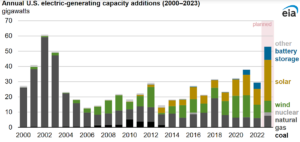 HE’s (HELCO) pattern of bait and switch on its energy transformation path to renewable energy replacements from its fossil fueled power plant investments is a failure when measured in terms of lost clean energy opportunities. It is also a failure of imagination and innovation that extends back into several generations of complicit state PUC – utility decisions. The exception to this period of unenlightened PUC decisions rubber stamping the utility’s poor energy choices, was an all too brief fruitful period of PUC leadership with Jay Griffin, who chaired the Commission from 2019 – 2022, and represented a period of clean energy regulatory leadership and decisions at their best within the state.
HE’s (HELCO) pattern of bait and switch on its energy transformation path to renewable energy replacements from its fossil fueled power plant investments is a failure when measured in terms of lost clean energy opportunities. It is also a failure of imagination and innovation that extends back into several generations of complicit state PUC – utility decisions. The exception to this period of unenlightened PUC decisions rubber stamping the utility’s poor energy choices, was an all too brief fruitful period of PUC leadership with Jay Griffin, who chaired the Commission from 2019 – 2022, and represented a period of clean energy regulatory leadership and decisions at their best within the state.
One shining example of the Griffin-led PUC regulatory period was guiding the utility towards cleaning up its dirty energy track record of energy combustion and polluting energy sources. HE saw which way the wind was blowing at the PUC, and advance the proposal and process for the addition to Hawaii Island’s grid of the AES Solar – Storage general plant in Waikoloa. The $47 million plant features zero GHG emissions and zero polluting energy byproducts, is fully energy free of imported and local supply chain disruptions and energy cost hikes. The AES solar plant further serves as HELCO’s show piece for doing something right for a change towards advancing the State’s and the County’s clean energy economy.
Unfortunately, this single example of 21st century clean energy power on Hawaii island (at utility scale) is just that a single example. Yes, there is some utility movement towards reconciling the island’s legacy wind farms and their future, but even those limited examples are outliers to overall poor and inefficient business decisions by the utility in serving its fiduciary role of serving ratepayer interests.
The AES solar plant features the most reliable and the lowest cost energy option the utility has to offer ratepayers. In comparison to the HELCO’s combustion power plant the AES plant deliveries electricity to ratepayers as little as 1/3 the cost of some other utility combustion power sources within Hawaii Island energy portfolio.
When the heavily promoted Hu Honua burning trees-for-power plant was proposed, HELCO expected utility power supply costs to jump to $0.44 cent per KWh, and compared to the AES solar+battery Waikoloa plant at a mere $.09 cents per KWh. The AES clean energy benefits represented a stark comparison in terms of ratepayer savings and climate benefits. With ratepayers picking up the entire energy cost, it had little impact the utility’s plans.
Another outstanding and differentiating AES clean power advantage of zero emissions power production is represented in offering Hawaii Island residents the highest levels of energy efficiency at the lowest cost on the Big Island grid today — areas which combustion power plants cannot compete – period. The economics of combustion-based and legacy utility power choices on ratepayers is clear – they cost more, considerable more than clean energy alternatives available to HELCO and HE statewide.
Equally important, these inefficient and hazardous energy choices block the statewide adoption of abundant solar-wind-batteries firm energy alternatives, and achieving essential progress in transforming Hawaii into a clean, resilient. and self-sufficient energy economy.
The utility-led arguments that so-called firm energy can only be accomplished with last century combustion power plants is a false argument. Battery storage is the game changer, along with other energy storage options including hydro transform so-called intermittent energy sources into on-demand energy assets which far more cost effective and resilient that legacy combustion power plants. It is only a matter scale, not technology limitations.
The AES solar plant is expected to result in total avoided fossil fuel consumption by HELCO of 511,086 barrels of oil within its first 25-years of operation, along the climate benefits of zero associated greenhouse emissions and no air pollution. AES solar power today fulfills over 7% of Hawaii Island’s electricity requirements, and resulted in another HELCO first — a customer a rate decrease and corresponding cost reduction in their monthly power bills, which are the highest power rates within the state.
Conclusion
If Hawaiian Electric is unable and/or unwilling to transition itself into a clean energy utility designed to serve the interests of the state’s residents and commercial interests in a period of rapid change and increasing climate challenges, then it’s time to open up Hawaii’s electricity market to better market options — one which is designed to serve the public interest, address the state’s energy self-sufficiency and climate sustainability needs, and do it before it’s too late…
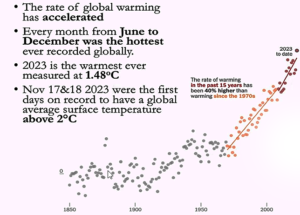 A warning heard loud & clear
A warning heard loud & clear A corresponding climate-sustainability message all presenters seem to agree on was the need for an urgent and statewide transition (one superseding old assumptions), and that time is not on our side when it comes to preparing for the inevitability climate changes. And, how Hawaii is ill-equipped to address a rapidly changing climate increasingly measured in lost opportunity, and rising economic and social costs.
A corresponding climate-sustainability message all presenters seem to agree on was the need for an urgent and statewide transition (one superseding old assumptions), and that time is not on our side when it comes to preparing for the inevitability climate changes. And, how Hawaii is ill-equipped to address a rapidly changing climate increasingly measured in lost opportunity, and rising economic and social costs.


 There are many wonderful and unique things about living in Hawaii, but personal transportation and vehicle ownership does not generally come to mind as one of them.
There are many wonderful and unique things about living in Hawaii, but personal transportation and vehicle ownership does not generally come to mind as one of them. The Idaho National Laboratory and other studies have determined today’s electric vehicles have an energy efficiency range of 3-to-4 miles range per each kWh consumed which translates into about 3.3 cents per mile travelled when electricity costs 10 cents per kWh. For Hawaii, HE utility Electric rates range from a low of 36 cents to 53 cents per KWh. The statewide average for all HE rate groups nears $0.50 per KWh, and when applied to the annual cost for home EV charging from utility-supplied power is still a bargain compared to gas-diesel powered vehicle fuel costs.
The Idaho National Laboratory and other studies have determined today’s electric vehicles have an energy efficiency range of 3-to-4 miles range per each kWh consumed which translates into about 3.3 cents per mile travelled when electricity costs 10 cents per kWh. For Hawaii, HE utility Electric rates range from a low of 36 cents to 53 cents per KWh. The statewide average for all HE rate groups nears $0.50 per KWh, and when applied to the annual cost for home EV charging from utility-supplied power is still a bargain compared to gas-diesel powered vehicle fuel costs.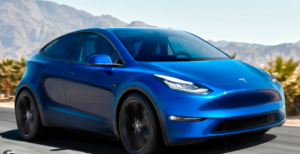 The new vehicle is code name the Model 2 by the media. It is expected to incorporate the economic, manufacturing, technology lessons and growth of Tesla’s recent past and which will guide the vehicle’s development and accelerate its time-to-market. The Model 2’s low entry price is targeted at $25,000, with little compromise anticipated in vehicle utility, performance, and range compared with Tesla’s current line of luxury models.
The new vehicle is code name the Model 2 by the media. It is expected to incorporate the economic, manufacturing, technology lessons and growth of Tesla’s recent past and which will guide the vehicle’s development and accelerate its time-to-market. The Model 2’s low entry price is targeted at $25,000, with little compromise anticipated in vehicle utility, performance, and range compared with Tesla’s current line of luxury models.


 In 1921, Congress passed the Hawaiian Homes Commission Act, which placed 200,000 acres of land that belonged to the Hawaiian Kingdom into a trust. Anyone 18 years or older with at least 50% Native Hawaiian lineage would be eligible to obtain a 99-year land lease for $1 a year. (The leases, which are still available, can be extended by another 100 years.)
In 1921, Congress passed the Hawaiian Homes Commission Act, which placed 200,000 acres of land that belonged to the Hawaiian Kingdom into a trust. Anyone 18 years or older with at least 50% Native Hawaiian lineage would be eligible to obtain a 99-year land lease for $1 a year. (The leases, which are still available, can be extended by another 100 years.)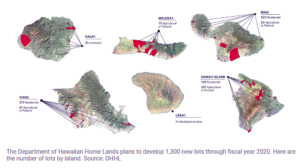 Another problem, experts say, is that the program has veered away from its goal of affordable home ownership. Residential homestead awards take several forms, including rent-to-own properties and vacant lots on which families can build their own homes. But the most sought-after option among homesteaders is buying prebuilt single-family homes on trust lands. While these turnkey houses cost about half the price of comparable homes elsewhere on the islands, they’re still prohibitively expensive for working-class families.
Another problem, experts say, is that the program has veered away from its goal of affordable home ownership. Residential homestead awards take several forms, including rent-to-own properties and vacant lots on which families can build their own homes. But the most sought-after option among homesteaders is buying prebuilt single-family homes on trust lands. While these turnkey houses cost about half the price of comparable homes elsewhere on the islands, they’re still prohibitively expensive for working-class families.

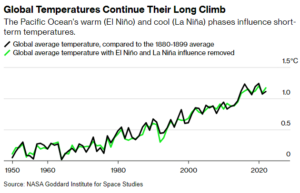
 Yes, extinction is a strong word until one takes the time to review the in-depth scientific findings of human-induced planet-warming. The results of the science are conclusive; a global heating effect is modifying the climate and ny extension, weather predictability (historic in human terms) and stability, impacting both traditional seasons and weather. This growing body of scientific evidence points to climate-conclusive changes now underway and their projected outcome.
Yes, extinction is a strong word until one takes the time to review the in-depth scientific findings of human-induced planet-warming. The results of the science are conclusive; a global heating effect is modifying the climate and ny extension, weather predictability (historic in human terms) and stability, impacting both traditional seasons and weather. This growing body of scientific evidence points to climate-conclusive changes now underway and their projected outcome.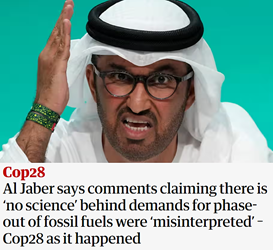 But, this year’s climate summit has also came at a time when 2023 has proven to be
But, this year’s climate summit has also came at a time when 2023 has proven to be  Rising P&C insurance costs are directly linked to housing (and the real estate market in total). Rising insurance costs, and the question of future property insurance costs, and even availability, is just one more example tied to costs of global heating and increasing cost of living factors, which translates into rising insurance costs added into their rent or mortgage payments, into food costs, and into their health costs. Altogether, failure to see the bigger and impactful picture of an economy based on fossil fuels, and continuing to live with fossil fuels wold’s primary energy source.
Rising P&C insurance costs are directly linked to housing (and the real estate market in total). Rising insurance costs, and the question of future property insurance costs, and even availability, is just one more example tied to costs of global heating and increasing cost of living factors, which translates into rising insurance costs added into their rent or mortgage payments, into food costs, and into their health costs. Altogether, failure to see the bigger and impactful picture of an economy based on fossil fuels, and continuing to live with fossil fuels wold’s primary energy source.
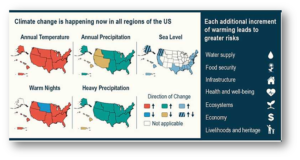 A Fifth National Climate Assessment report issued today by the US government describes how intensifying climate change is disrupting lives and businesses nationwide, even as communities in every state ramp up their response to the crisis:
A Fifth National Climate Assessment report issued today by the US government describes how intensifying climate change is disrupting lives and businesses nationwide, even as communities in every state ramp up their response to the crisis: 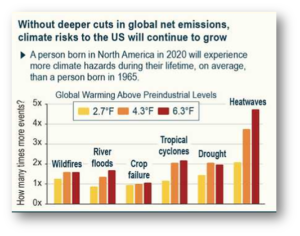 Minor and moderate coastal flooding is also on the rise along most Atlantic and Gulf coastlines, while a combination of rising seas and flooding from high tides and big storms is projected for the the mid-pacific and Hawaiian island chain. Meanwhile, warmer winters are contributing to declining snowpack levels in the Northwest, affecting water supplies.
Minor and moderate coastal flooding is also on the rise along most Atlantic and Gulf coastlines, while a combination of rising seas and flooding from high tides and big storms is projected for the the mid-pacific and Hawaiian island chain. Meanwhile, warmer winters are contributing to declining snowpack levels in the Northwest, affecting water supplies.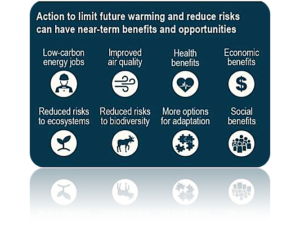 The more warming there is, the worse the impacts will be. Science can’t tell us exactly how hot the planet will get because that depends on what we — society as a whole but especially our political leaders — decide to do. In the US, and elsewhere in the world, people have a choice right now to do more to cut their carbon footprint and prevent much worse warming.
The more warming there is, the worse the impacts will be. Science can’t tell us exactly how hot the planet will get because that depends on what we — society as a whole but especially our political leaders — decide to do. In the US, and elsewhere in the world, people have a choice right now to do more to cut their carbon footprint and prevent much worse warming.
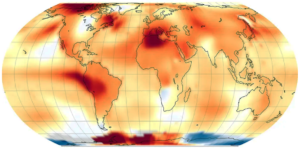 Global sea surface temperatures broke new record highs, and Antarctic sea ice continues its unprecedented meltdown.
Global sea surface temperatures broke new record highs, and Antarctic sea ice continues its unprecedented meltdown. It’s real. It’s happening. It’s accelerating. And it’s our fault. Human activity — particularly the production of greenhouse gasses from fossil fuel emissions — it is reshaping our planet, and Hawaii will not escape the effects of rapid environmental change now occurring at rates never seen before, certainly since humans walked the Earth.
It’s real. It’s happening. It’s accelerating. And it’s our fault. Human activity — particularly the production of greenhouse gasses from fossil fuel emissions — it is reshaping our planet, and Hawaii will not escape the effects of rapid environmental change now occurring at rates never seen before, certainly since humans walked the Earth. The Heat Will Kill You First (2023) warns that extreme heatwaves are becoming more common and are dramatically altering life as we know it – they’re an existential danger. Rising temperatures are already changing the planet, shortening seasons and intensifying disasters.
The Heat Will Kill You First (2023) warns that extreme heatwaves are becoming more common and are dramatically altering life as we know it – they’re an existential danger. Rising temperatures are already changing the planet, shortening seasons and intensifying disasters.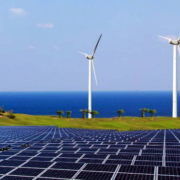

 HE’s (HELCO) pattern of bait and switch on its energy transformation path to renewable energy replacements from its fossil fueled power plant investments is a failure when measured in terms of lost clean energy opportunities. It is also a failure of imagination and innovation that extends back into several generations of complicit state PUC – utility decisions. The exception to this period of unenlightened PUC decisions rubber stamping the utility’s poor energy choices, was an all too brief fruitful period of PUC leadership with Jay Griffin, who chaired the Commission from 2019 – 2022, and represented a period of clean energy regulatory leadership and decisions at their best within the state.
HE’s (HELCO) pattern of bait and switch on its energy transformation path to renewable energy replacements from its fossil fueled power plant investments is a failure when measured in terms of lost clean energy opportunities. It is also a failure of imagination and innovation that extends back into several generations of complicit state PUC – utility decisions. The exception to this period of unenlightened PUC decisions rubber stamping the utility’s poor energy choices, was an all too brief fruitful period of PUC leadership with Jay Griffin, who chaired the Commission from 2019 – 2022, and represented a period of clean energy regulatory leadership and decisions at their best within the state.